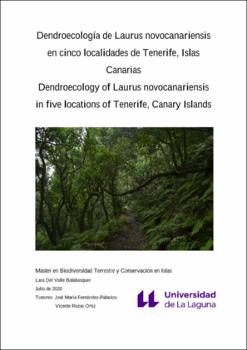Dendroecología de Laurus novocanariensis en cinco localidades de Tenerife, Islas Canarias
Author
Del Valle Balabasquer, LaraDate
2021Abstract
La laurisilva de las Islas Canarias es un ecosistema sometido históricamente a una importante
presión humana. Las actividades agrícolas, ganaderas y de aprovechamiento forestal han influido
notablemente en este bioma hasta mediados del siglo XX. La aplicación de la dendrocronología
al estudio de la dinámica forestal de la laurisilva es escasa, ya que el carácter subtropical de este
bosque había hecho suponer la ausencia de anillos de crecimiento anuales en la madera de las
especies arbóreas que lo conforman. Sin embargo, estudios en otros archipiélagos macaronésicos
han revelado la presencia de anillos en varias especies de la laurisilva. Este trabajo se centra en el
laurel (Laurus novocanariensis), especie predominante en la laurisilva canaria, y pone de
manifiesto la utilidad del análisis de sus anillos de crecimiento como herramienta para reconstruir
la historia reciente de este ecosistema. Los resultados muestran la historia del dosel forestal en
cinco localidades en la isla de Tenerife con representación de laurisilva, consecuencia del
diferente manejo llevado a cabo en cada una de ellas, así como el proceso de regeneración del
bosque tras el cambio progresivo en el modelo socioeconómico de la isla y el papel de las
tormentas como fuente de perturbaciones naturales en la laurisilva. The laurel forest in the Canary Islands is an ecosystem historically subjected to significant
human pressure. The agricultural, livestock and forestry activities have greatly influenced this
biome until the middle of the 20th century. The application of dendrochronology to the study of
the laurel forest dynamics isscarce, since the subtropical character of this forest had led to suppose
the absence of annual growth rings in the wood of the tree species that form it. However, studies
in other Macaronesian archipelagos have revealed the presence of these rings in various species
of laurel forest. This work focuses on Laurus novocanariensis, a predominant species in the
Canarian laurel forest, and highlights the usefulness of the analysis of its growth rings as a tool to
reconstruct the recent history of this ecosystem. The results show the canopy history of five sites
on the island of Tenerife with laurel forest representation, a consequence of the different past
management in each one of them, as well as the process of forest regeneration after the progressive
change in the socioeconomic model of the island and the role of storms as a source of natural
disturbances in the laurel forest.




